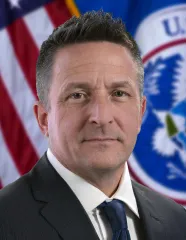Guest post from Norman Speicher, program manager in the Science and Technology Directorate’s (S&T) Office of Mission and Capability Support.

The increasing frequency of severe weather events across the United States, most recently including hailstorms, tornadoes, and wildfires (and soon to include hurricanes and tropical storms) puts countless lives at risk and causes millions of dollars of damage to critical infrastructure. These recent weather phenomena are stark reminders that safeguarding our communities from the effects of these events is an ever-evolving, nonstop effort that requires innovation and collaboration across the Department of Homeland Security (DHS) and its partners and stakeholders.
Remaining vigilant and prepared to protect our nation from severe weather is one of S&T’s highest priorities. One way we are accomplishing this is through the Emergency Preparedness and Response to Weather Extremes initiative (EMPOWER) pilot program, a collaboration with the State University of New York (UAlbany) that is actively developing a suite of weather-related support tools that give federal, state, and local New York first responders access to real time analytics/artificial intelligence, weather data, and visualization capabilities.
The EMPOWER project leverages the FEMA-funded New York State Mesonet, which was developed by UAlbany and became operational in April 2018. Located throughout the state, NYS Mesonet weather stations are equipped with state-of-the-art automated environmental and weather sensors, collect critical Mesonet data such as temperature, humidity, wind speed and direction, air pressure, precipitation, solar radiation, snow depth, and soil information, and utilize high-definition cameras that capture photos of the surrounding environments every five minutes. This data is then shared via a dashboard with regional emergency personnel to help them respond as severe weather events occur.

Initial feedback from local first responders and weather experts indicates that the EMPOWER network provides a wealth of data and information—so much, in fact, that it can sometimes be difficult to quickly sift through and identify what is immediately useful and actionable.
S&T and UAlbany are now launching an effort to identify exactly what types of EMPOWER information and data are useful to responders, emergency managers, and other relevant stakeholders in the field and will soon develop a complementary dashboard to translate all of it into easily accessible response tactics that can be immediately implemented during severe weather events.
To accomplish this, the EMPOWER team recently curated a group of federal, state, and local response stakeholders, including representatives of several DHS agencies and the National Weather Service, and will lead interviews, roundtables, and meetings with regional first-on-scene responders and weather SMEs. Feedback from these efforts, along with analyses of responses to recent severe weather events in New York State, will all guide the development of a dynamic and customizable web-based dashboard that will aggregate the key data and make it more easily digestible so those on the front lines can execute more rapid, tailored responses.
Once the dashboard has been developed, the EMPOWER stakeholder group will conduct training sessions for users and organizations that are interested in incorporating it into their existing suite of emergency response tools.
This pilot project is currently a proof of concept. However, we expect that the EMPOWER sensor network, dashboard, and associated severe weather response strategies will significantly influence and shape the development and implementation of similar networks and tools across the country in the near future. Similar weather networks are already being funded and built, and the incredible data they will provide has the potential to help other responders and emergency managers around the nation improve their situational awareness and response tactics during future extreme weather events.
I look forward to keeping an eye on this exciting initiative and updating you in the coming months.
Together, with our partners, we will continue to innovate and develop technologies that help our first responders keep our communities safe from severe weather events both today and tomorrow. Check out our First Responder Capability and Community and Infrastructure Resilience pages to learn more about other technologies that S&T is developing to protect both our responders and communities.
